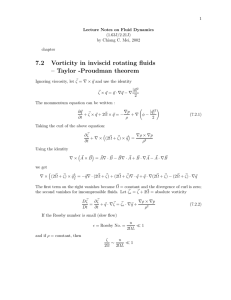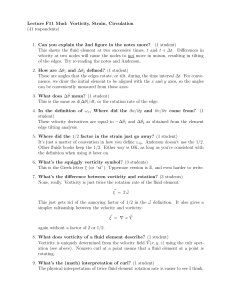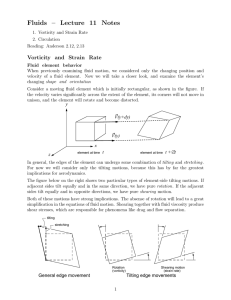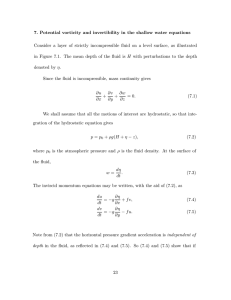5. Consider two closed material curves on two adjacent surfaces along... σ ) is a constant, as ...
advertisement
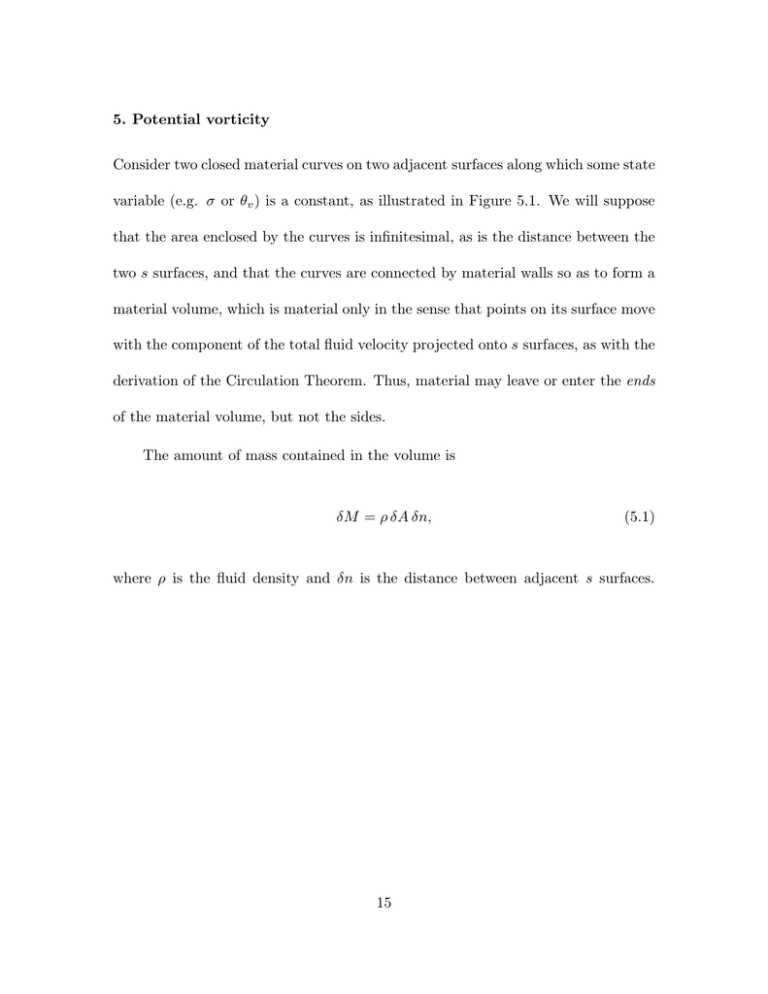
5. Potential vorticity Consider two closed material curves on two adjacent surfaces along which some state variable (e.g. σ or θv ) is a constant, as illustrated in Figure 5.1. We will suppose that the area enclosed by the curves is infinitesimal, as is the distance between the two s surfaces, and that the curves are connected by material walls so as to form a material volume, which is material only in the sense that points on its surface move with the component of the total fluid velocity projected onto s surfaces, as with the derivation of the Circulation Theorem. Thus, material may leave or enter the ends of the material volume, but not the sides. The amount of mass contained in the volume is δM = ρ δA δn, (5.1) where ρ is the fluid density and δn is the distance between adjacent s surfaces. 15 Figure 5.1 Since n lies in the direction of ∇s, δn = dn δs, ds (5.2) where δs = s2 − s1 is the difference between the values of s on the two surfaces. 16 Using (5.1) and (5.2), the incremental area, δA, may be written δA = 1 ds δM. ρδs dn (5.3) Using this, the Circulation Theorem in the form (4.8), with the integrals taken over the infinitesimal areas, can be written 1 ds 1 ds d Ω) · n̂ δM. (∇ × V + 2Ω δM = (∇ × F) · n̂ dt ρδs dn ρδs dn (5.4) Given that the direction of n̂ is the same as that of ∇s, and that δs is by definition a fixed increment in s, (5.4) may be re-expressed d Ω) · ∇s δM ] = α(∇ × F) · ∇s δM. [α(∇ × V + 2Ω dt (5.5) The variability of δM can now be related to sources and sinks of s, since clearly if fluid is entering or leaving through the ends of the volume, which lie on surfaces of constant s, then there must be sources or sinks of s. The rate of mass flow across each end of the cylinder is ρ ds dn δA, dt ds so that the rate of change of mass in the cylinder is the convergence of the flux: ∂ ds ∂ ds ds dn d d δM = − ρ δA δn = −ρδA δn = −δM . dt dn dt ds ∂s dt ∂s dt (5.6) Using this in (5.5) gives d Ω) · ∇s] = [α(∇ × V + 2Ω dt SD Ω) · ∇ α(∇ × F) · ∇s + α(∇ × V + 2Ω . dt 17 (5.7) This known at Ertel’s Theorem and states that the quantity Ω) · ∇s α(∇ × V + 2Ω is conserved following the fluid flow, in the absence of friction or sources or sinks of s. It is customary to use θ as the relevant state variable in the atmosphere, al­ though it is more accurate to use θv , since it accounts for the dependence of density of water vapor. We shall therefore define the potential vorticity, for atmospheric applications, as Ω) · ∇θv , qa ≡ α(∇ × V + 2Ω (5.8) and in the ocean, we will use potential density, σ, for s: Ω) · ∇σ. qo ≡ α(∇ × V + 2Ω (5.9) Thus, according to (5.7), the conservation equations for qa and qo are dqa dθ Ω) · ∇ v , = α(∇ × F) · ∇θv + α(∇ × V + 2Ω dt dt (5.10) dqo dσ Ω) · = α(∇ × F) · ∇σ + α(∇ × V + 2Ω . dt dt (5.11) and 18 In the atmosphere, potential vorticity is conserved in the absence of friction or sources of θv ; it is conserved in the ocean in the absence of friction or sources of σ. Returning to Figure 5.1, it is seen that in the absence of sources or sinks of s, the drawing together of the two s surfaces implies, by mass conservation, that the volume expands laterally as it is squashed; by the Circulation Theorem, the absolute vorticity must decrease. This is precisely what (5.7) indicates. Potential vorticity can be thought of as that vorticity a fluid column would have if it were stretched or squashed to some reference depth. Volume conservation of potential vorticity The integral of potential vorticity over a finite mass of fluid is conserved even in the presence of friction or sources of σ or θv , as long as those effects vanish at the boundaries of that mass of fluid. The potential vorticity tendency integrated over a fixed (material) mass is dq d ρ dx dy dz = dt dt qρ dx dy dz. We can take the time derivative outside the integral because mass is conserved. Using (5.7) d dt ρq dx dy dz = ds Ω) · ∇ (∇ × F) · ∇s + (∇ × V + 2Ω dx dy dz. dt (5.12) Since the divergence of the curl of any vector vanishes, and since Ω is a constant 19 vector, (5.12) can be rewritten d ds Ω) dx dy dz ρq dx dy dz = ∇ · s(∇ × F) + (∇ × V + 2Ω dt dt ds Ω) · n = s(∇ × F) + (∇ × V + 2Ω ˆ dA, dt (5.13) where the last integral is over the entire surface bounding the volume and n̂ is a unit vector normal to that surface. (We have used the divergence theorem here.) Thus, the mass integral of q is conserved if there are no sources of s or friction on the boundaries of the fluid mass. 20 MIT OpenCourseWare http://ocw.mit.edu 12.803 Quasi-Balanced Circulations in Oceans and Atmospheres Fall 2009 For information about citing these materials or our Terms of Use, visit: http://ocw.mit.edu/terms.
